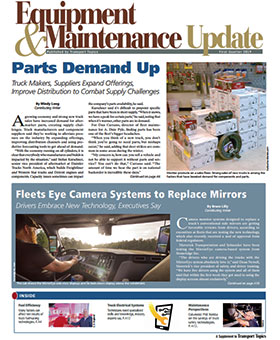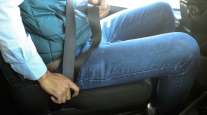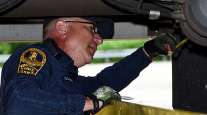CVSA: Mirrors Have Role in Roadside Inspections

Camera monitoring systems promise to improve highway safety by giving truck drivers better visibility around the outside of the truck, but removing the mirrors could force highway safety inspectors to change their practices, according to the executive director of the Commercial Vehicle Safety Alliance.
RELATED: Fleets Eye Camera Systems to Replace Mirrors
At the spring CVSA Workshop in Portland, Ore., last year, a truck cab was equipped with the Stoneridge MirrorEye camera monitoring system in place of conventional mirrors.
“We looked it over carefully,” said Collin Mooney, CVSA’s executive director. “The one thing that came up as a concern for law enforcement officers was not having the mirrors available when approaching the vehicle.”
The ability to look into the mirrors allows officers to assess the driver’s behavior. “This has been taught to officers for decades as a fundamental safety practice,” Mooney said. “Is the driver looking at you, fidgeting with something in the cab or doing something else?”
The one thing that came up as a concern for law enforcement officers was not having the mirrors available when approaching the vehicle.
Collin Mooney, CVSA
The Federal Motor Carrier Safety Administration on Dec. 26 announced it issued a five-year exemption to Stoneridge Inc. to allow its aftermarket MirrorEye mirrorless digital camera and sensor system to be installed on trucks and motor coaches as an alternative to traditional mirrors, Transport Topics reported.

CVSA has a policy of supporting improvements in transportation safety, and camera monitoring systems fall into that category. Although it is in favor of safety technology and automated driving systems, Mooney said the organization believed it was important to raise the issue concerning this use of mirrors by roadside inspectors.
James Burg, president of James Burg Trucking Co., pointed out that stopped trucks are relatively safe. “I understand that law enforcement and roadside inspectors may make use of mirrors to assess things inside a stopped vehicle as they approach the driver, but we have to look at this from the whole view,” he said. “For carriers, if this technology provides a substantially better way for drivers to see the vehicles around them, then there will be significantly fewer accidents.”
Advances in the technology used to conduct inspections may solve the problem. “We’re moving closer to conducting inspections electronically, so there will not be any need for an officer to walk up to a truck,” said Dean Newell, vice president of safety and driver training for Maverick Transportation.

Newell
Newell looks forward to the day when inspections can happen while the truck is driving down the road. “Our truck passes under a reader and they can get the codes off of the truck and the driver’s ELD data,” he said. “They can use our DOT number to determine if we have any problems in any areas. All of that is available or will be before long.”
CVSA is working to make this a reality. In a connected world with advanced driving systems, the roadside inspection program will evolve, Mooney said.
“We have a handful of petitions and initiatives underway in an effort to leverage technology to enhance transportation safety,” Mooney said. “In a few years, we may not even need to stop a commercial motor vehicle in order to inspect it.”





